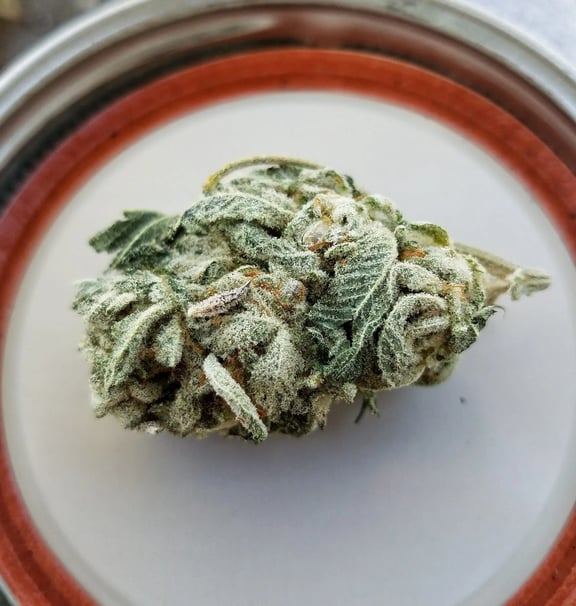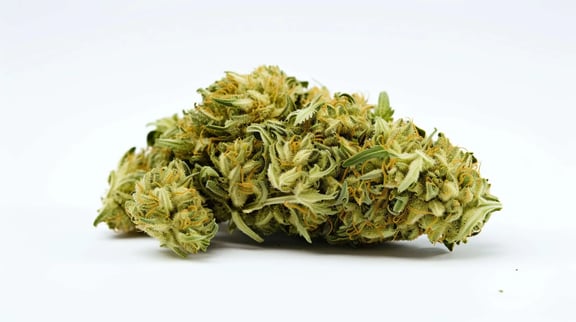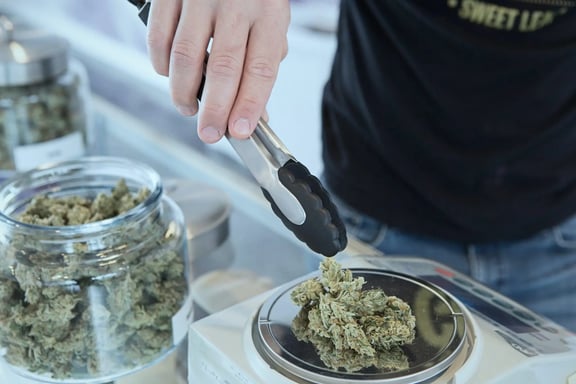Cannabis, a plant with a rich tapestry stretching back millennia, has recently experienced a resurgence, especially with the global trend towards medical cannabis legalisation. Whether you’re a seasoned cannabis enthusiast or a newer consumer, understanding the distinctions between categories of cannabis strains, notably Indica and Sativa weed strains, can be illuminating. So, let’s journey into the intricate worlds of Indica and Sativa.
Indica vs. Sativa Weed Strains
Before we kick off our description of Indica vs. Sativa and the differences between each, important caveats must be made. Firstly, as our understanding of the cannabis plant has expanded exponentially in recent years, humans have stopped using the Indica/Sativa distinctions in quite the same way. In 2023, calling something an indica or a sativa botanically refers to how the plant itself grows, with Indica’s being traditionally more broad and short than their taller sativa counterparts. These two categories of weed actually arise from the plant being discovered in different locations by different people. The genus of Cannabis was first classified by Carl Linnaeus in 1753, using his “modern” system of taxonomic nomenclature, which is still in use for the naming of species. He considered the genus to be monotypic, having just a single species that he named Cannabis sativa L. Cannabis Indica L. was discovered to have originated either on the Asian subcontinent or possibly in Afghanistan. French naturalist Jean-Baptiste Lamarck was the first European botanist to classify this type in 1785, 32 years after Cannabis Sativa L. Later, these plants were found to be part of the same genus (Cannabis Sativa L.), but indica persisted, and we still find weed strains listed as indica and sativa today.
Let’s talk about how this was previously approached, and then dissect the information to get to the bottom of these cannabis distinctions.
Indica Weed Strains:

Photo by Cambridge Jenkins IV on Unsplash
Picture a serene evening. The world fades into the background, and you’re ensconced in your favourite spot, enveloped in a deep sense of relaxation. This was thought to encapsulate the Indica strain experience. Classically, ‘indica’ weed strains originate from the world’s eastern regions and are recognised by their compact, bushy form. They have been sought as the quintessential choice for those yearning for relaxation, tranquillity, or a profound sleep. The sensations they induce are often termed “body high”, akin to a comforting embrace. But we now know that these effects are found in plenty of strains we’d consider’sativa’ strains, not to mention the hybrids!
Origin and Appearance: Indica weed strains originate from supposedly colder areas of the globe, notably the mountainous terrains of Afghanistan and certain regions in India. Characteristically, these strains display a compact and stout appearance, adorned with wide, deep green leaves. When it comes to growth patterns, indica weed strains tend to have a denser structure with an abundance of side-branches, setting them apart from their sativa counterparts.
Effects: Indica strains have been renowned for their relaxing properties, although this is a misnomer. They are said to induce a “body high“, making users feel deeply relaxed, even sedated in higher doses. This was thought to make them an excellent choice for evening use or when one seeks deep relaxation.
Cultivation: Indica cultivars thrive under extended daylight and shorter nights, a condition termed the long photoperiod. At this time, the plant focuses on bolstering its physical presence. However, as the balance shifts to longer nights, signalling the approach of autumn, Cannabis Indica transitions to its flowering stage. Note here that this is precisely what Sativa strains also do during growth.
Medical Benefits: Many turn to Indica weed strains for pain relief, to combat insomnia, and to alleviate stress and anxiety. Its relaxing properties can also help with muscle spasms and seizures. What people should be searching for are strains that have a terpene profile featuring relaxing terpenes, like Linalool, which is known for its relaxing, sedative properties.
Some of the well-known ‘classic indica’ weed strains include Northern Lights, Blueberry, and Granddaddy Purple.
Sativa Weed Strains:

Image provided by Releaf via Cannabis Images
Moving onto sativa weed strains. Some folks wonder if there’s still such a thing as a pure sativa strain these days. Truth be told, they’re out there but they’re like gold dust, because the plants take longer to grow than their indica-dominant sisters and the flowering cycle is also longer. But this isn’t a bad thing, in fact it helped with the blending of indica and sativa strains over the past 60 years to give birth to the hybrids which dominate the market today. These hybrids can inherit the best of both traits from both their sativa and indica parents. This why you’ll often hear people chatting about “Sativa-dominant” or “Indica-dominant” strains nowadays. Let’s dive into sativa weed strains and what they were traditionally thought consist of,
Visualise a day pulsating with energy. Your thoughts race, filled with creativity and the desire to explore or engage in lively chatter. This was thought to capture the essence of the Sativa strain, although we now know it to be a misnomer. Indigenous to warmer regions, these strains are tall and lean. The thinking from those selecting sativa-dominant strains are that they want something which resonates with an uplifting energy, making it perfect for daytime activities, social interactions, or creative pursuits. This can be more accurately determined by knowing the THC potency and terpene balance of a strain.
Origin and Appearance: Sativa weed strains are native to warmer regions, such as Southeast Asia, Central America, and parts of Africa. They grow tall and thin, reaching heights of up to 12 feet, with narrow, light green leaves.
Effects: Rightly or wrongly, sativa weed strains are known for their uplifting and cerebral effects. They’re said to induce a “mind high”, boosting creativity, focus, and energy. This makes them a preferred choice for daytime use or when engaging in social activities for consumers.
Medical Benefits: Sativa strains are often sought after for their ability to alleviate mood disorders, increase appetite, and combat fatigue. They can also be beneficial for those with depression, ADHD, or chronic pain. Indica are good for all of the above as well, by the way.
Popular Sativa Strains: Some of the standout Sativa-dominant weed strains include Sour Diesel, Jack Herer, and Green Crack.
Hybrids: Marrying Indica and Sativa Traits

Photo by Budding . on Unsplash
Hybrid strains seamlessly blend the characteristics of both Indica and Sativa weed strains, crafting a balanced experience. Their effects can swing from the soothing touch of Indica to the vibrant spark of Sativa, catering to those who desire a mix or a particular equilibrium.
Terpenes: The Silent Maestros
While the distinction between Indica and Sativa weed strains offers a foundational grasp, the real allure is spun by terpenes. These aromatic compounds bestow cannabis strains with their unique fragrances. But their influence isn’t limited to scent alone. They play a pivotal role in shaping the effects of cannabis. For instance, linalool, prevalent in lavender, is also present in certain cannabis strains, imparting soothing effects, whether that strain is known as indica or sativa dominant. On the other hand, limonene, with its citrusy essence, can elevate one’s mood, again, whether contained within indica or sativa strains. When terpenes synergise with cannabinoids like THC and CBD, they produce the ‘entourage effect’, a harmonious concert where the collective impact transcends individual contributions, giving each strain it’s own unique effects.
THC in Indica, Sativa and Hybrid Weed Strains:
THC, while famed for its heady highs, isn’t just about the trip. It’s the magic behind the cannabis curtain, pulling the strings of that iconic euphoria. If you’re in the mood for a mind journey, THC is your ticket. But beyond the clouds and giggles, there’s a serious side to THC. Dive into the world of cannabis and you might discover:
Pain Relief: Got a nagging pain that just won’t quit? THC’s got your back. It’s like a gentle massage for both body and mind, easing those aches away.
Nausea: If your stomach’s doing the cha-cha against your wishes, a bit of THC might just calm that dance down. It’s known to help with nausea and even keep those unwanted upchucks at bay.
Lack of Appetite: If your appetite’s gone on holiday, THC might lure it back. It’s the unsung hero behind those midnight snack raids, but for some, it’s a real game-changer in getting them to eat.
Insomnia: Counting sheep or ceiling tiles? THC can be like a warm blanket, wrapping you up and guiding you to the land of nod.
Cancer’s Foe: While it’s not a silver bullet, there’s some pretty promising research out there suggesting THC might be a thorn in the side of cancer cells. More research is needed.
Beyond Strain Labels: A Personalised Cannabis Experience

Image provided by Releaf via Cannabis Images
As we can see from above, Indica and Sativa might still be useful in some situations for classifying cannabis. However, as we increasingly understand the plant, this distinction is becoming less accurate and less important.
Moreover, factors like individual physiology, current mood, and even the setting can influence one’s interaction with a strain. So, rather than strictly adhering to strain labels, consider your desired effects. Seeking relaxation, a burst of energy, or a creative surge? Let these aspirations guide your selection.
Summary
Cannabis, with its rich tapestry, weaves together history, science, and personal experiences. While Indica’s traditionally were thought of as sleepy, relaxing strains, we now know that is not the case.
A botanical classification over 150 years ago has led to the persistence of a myth that cannabis is distinctly different…from itself. While the plant’s growth and flowering cycle timings may be different, underneath it all, cannabis is the same plant.












.jpg)